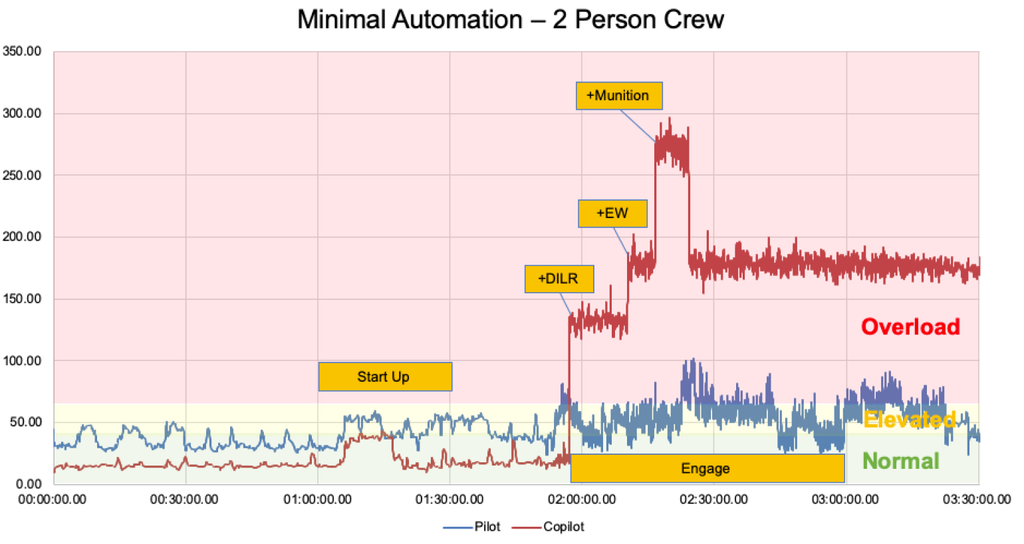Learning Management System for Future Aviators
HF Designworks and Wingman Defense develop a Learning Management System (LMS) to help aviators use Multi-Domain Data Fusion (MDDF) and Artificial Intelligence (AI) for advanced teaming with unmanned assets.
HF Designworks and Wingman Defense’s solution integrates cognitive burden insights with AI and autonomy systems in simulated missions to educate and inform aviators how to best use Multi-Domain Data Fusion (MDDF) to control and leverage Artificial Intelligence (AI)-powered unmanned assets; increasing mission success while reducing instances of high workload.
Goals & Mission Statement
To assist pilots in leveraging AI and MDDF for enhanced mission success.
The mission – and pilot – of the future must manage vastly larger data volumes while leveraging unmanned assets as an integral part of every mission. Our solution first teaches pilots how AI and MDDF can help them master these challenges, then puts these pilots into simulated missions where they gain mastery of – and confidence in – these systems. The incorporation of AI systems for control and visualization of UAS systems through AI-powered MDDF is essential to maximize Situational Awareness (SA) while keeping workload at manageable and mission sustainable levels.
Flexible Architecture
By leveraging open source and Commercial Off-The-Shelf (COTS) software and hardware products we have made a low cost, high value LMS with an adaptive and flexible architecture to support a variety of end users, platforms, and technologies.
Our current LMS was built to support the Navy and Army Future Vertical Lift (FVL) Future Long-Range Assault Aircraft (FLRAA) and Future Attack Reconnaissance Aircraft (FARA) platforms engaging in envisioned world battles. However, our LMS can easily be revised to support current aviators on existing, and emerging systems and technologies.
By leveraging human performance modeling and combining it with a training simulator as part of a near-real time iterative advanced teaming improvement loop we can continually measure and improve asset capabilities and data fusion paradigms for greater mission success in a way that has never been done before, and frankly in a system that is far less expensive than what is offered today.
Scott Scheff HF Designworks
Dual-Training Of Pilot And Ai
Our breakthrough insight in the development of our LMS solution is that by training pilots to collaborate with and understand AI systems and precisely measuring these interactions, we also produce essential training data which enables us to iterate toward enhanced AI systems which better serve the pilot.
This dual-training architecture jointly improves pilot skills and the autonomous tools which serve the aviator. When Future Vertical Lift (FVL) aircraft, for example, are ready for their first missions, our system will have iterated toward optimal advanced teaming configurations, with highly-trained pilots who already master the full range of highly refined autonomous capabilities necessary for victory on tomorrow’s battlefield.
Comprehensive Solutions
Leveraging the Improved Performance Research Integration Tool (IMPRINT), we built mission models and evaluated the mental workload of two-person and single-person rotorcraft crews conducting attack and reconnaissance missions. We assessed current-world and envisioned-world settings in which FLRAA operators commanded a range of unmanned aircraft. We explored the use of advanced automation, artificial intelligence, and decision aiding technologies to support operators in managing periods of excessive workload. We then created a LMS to support training and educating aviators to understand how to best implement MDDF and AI in their missions. This enables us to identify and reduce periods of high workload while enhancing mission performance.
Integrated Analysis
Our team is comprised of AI experts, human performance modelers, human factors engineers, aviation training subject matter experts (SMEs), and LMS developers from HF Designworks (www.hfdesignworks.com) and Wingman Defense (www.aiwingman.com). The team applied a complementary set of cognitive systems engineering methods (functional analysis, cognitive task analysis, and discrete event modeling) to identify areas of highest workload, and then determined through technologies such as MDDF and AI areas of workload that could be effectively reduced as well as areas of the mission where effectiveness could be improved. The team then built an LMS to support findings and improve aviator mission effectiveness.

